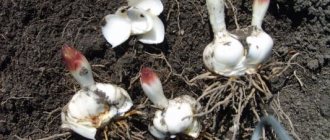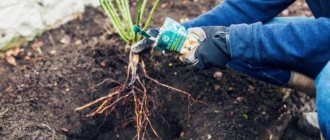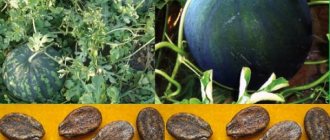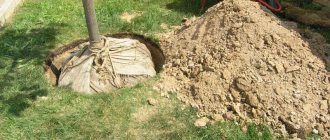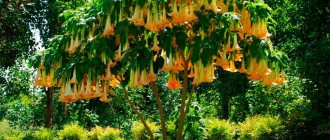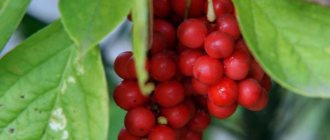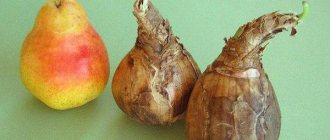Why propagate pears
If it is always possible to buy a seedling in order to plant it without problems, then many gardeners decide to do so. But in order to preserve and propagate a pear yourself, you can carry out a number of fairly simple procedures.
It happens that it is simply not possible to buy a seedling, but it is very necessary to preserve the pear. Let’s say there is no way to go to the city to the market or to the nursery. Or an inquisitive gardener will simply decide to improve his skills and start a new business.
What is the easiest way to propagate a pear?
SeedsVegetatively
Reproduction by root shoots
Propagation of forsythia by cuttings - how to propagate in summer
When using this method, you should use two-year-old pear seedlings growing at its base on the sunny side. To replant, you need to dig out the tap root of the plant, which is directed towards the mother tree. It should be cut off, and then the young seedling should be transplanted to a new place.
You can separate the root shoots in early spring or autumn before the beginning of the growing season, or at its end.
How to propagate pears
There are several methods for propagating pear trees. The main methods are seed and asexual or vegetative.
In turn, the vegetative method is divided into several different types:
- cuttings;
- air layering;
- vaccination;
- basal shoots.
Pear is the queen of the garden.
Seed propagation
A pear can be grown from a small seed. This requires a little time and skill. But, most often, this method is only suitable for obtaining a strong rootstock, onto which a varietal pear will then be grafted.
The process of growing a pear tree is carried out as follows:
- To get the seed, you need to find a few pears under a tree, leave them until they soften, but do not rot. Carefully cut the fruit and remove the seeds. They should be a rich dark color, brown or black, elastic and thick.
- The seeds should be rinsed well under running water, dried and placed in a paper bag for storage.
- Planting seeds can be done immediately in the fall or in the spring.
- To place seeds in open ground, you need to soak them in advance in water at room temperature, approximately 3 days before the intended planting.
- You need to add a fertile mixture of peat and humus to the soil and add superphosphate.
- The seeds are placed in the mixture at a distance of about 5 cm between seeds and 10 cm between rows.
- When the first seedlings hatch, they will need to be thinned out.
- Everyone needs proper watering and mulching.
- You can initially place the seeds in pots and place them in the room on the windowsill. Then, as they grow, they will need to be replanted, and after a season they can be moved to a new place.
Unfortunately, the process of growing from seed does not give one hundred percent results. It is not always possible to preserve all the characteristics of the mother variety.
Pear seeds prepared for planting.
Cuttings
The method of growing a pear from a cutting is one of the vegetative ones. It means cutting, growing and planting shoots from part of the branches. They must be collected from a tree that is about 6 years old or older.
Top shoots cannot be used to take cuttings.
Deadline for cutting cuttings
Cut cuttings.
In order for the shoots to take root correctly, they need to be prepared in a timely manner. Depending on the climate zone in which they will be grown:
- in summer, cuttings are collected between mid-June and July, but if the spring is cold, then even a couple of weeks later;
- In autumn, the cuttings are cut after the leaves fall, but before frost.
How to cut a cutting
The branch for the future seedling must be selected in advance. It should be smooth, healthy, green on top and woody on the bottom. You need to cut it like this:
- The pieces should be small, 20 cm in length.
- They must have at least 3 leaves.
- The bottom cut is at an angle of 45 degrees upward to the bud.
- The tops are cut straight.
Rooting process
In order for the cutting to immediately begin to grow, it needs to be rooted correctly. First of all, you need to make a nutrient mixture in a box or convenient drawer. It could be:
- organic matter with black soil;
- moss and sand on top;
- peat and vermiculite;
- peat and sand.
Before planting in the ground, you need to properly prepare the cuttings:
- Cut off the bottom sheets.
- Cut the remaining ones in half.
- Soak in rooting agent.
- Place in the substrate so that there is a small distance between them.
You will need to care for the cuttings as follows:
| Step 1 | After planting, cover with film. |
| Step 2 | Lightly spray the branches every 7 days. |
| Step 3 | Protect from bright sunlight. |
| Step 4 | Every day you need to open it for 2-3 hours so that there is access to fresh air. |
| Step 5 | You need to monitor the leaves so that they do not rot. |
| Step 6 | Roots will appear within a month. |
Seedlings should be placed in open ground in the fall. They are separated one at a time and placed in separate pits or transferred with the whole lump to a planting pit. In order for young plants to adapt normally to cold weather, they need to be covered.
The process of rooting cuttings.
How to care for cuttings in the ground
In spring, seedlings begin to develop quickly. Caring for them is not difficult, but it is necessary to take into account a number of features:
- Water the trees through a hole in the tree trunk.
- Mulch the tree trunk circle.
- Feed with a small amount of nitrogen until June, then with mineral fertilizers.
- In the fall, each tree will need to be insulated separately.
Reproduction by air layering
This method is good because it guarantees the complete preservation of all varietal characteristics of the plant. Also, layering is done quite simply, the method is suitable for beginners.
The tree must be young, about 3-4 years old. If the branch bends down from below, you can install a plastic box. If the shoot is chosen quite high, then you can put a bottle on it.
The reproduction process is carried out as follows:
- Place a nutrient substrate of humus, peat and garden soil into the container.
- A branch is bent to it, on the bark of which you need to make several notches, sprinkle it with Kornevin and pin it to the bottom.
- It is necessary to keep the soil moist and, in hot weather, shelter from the hot sun.
- For the winter, the branch is not yet separated, but covered with a box and covered with snow.
- You need to separate the cuttings with sharp pruning shears in the second year.
- The seedling needs to be placed with a lump of soil in a pre-prepared planting hole.
- You can care for them in the same way as ordinary seedlings.
Air layering.
Reproduction by root shoots
Root shoots often appear near the tree trunk, which are suitable for pear propagation. But only two-year-old shoots are suitable for separation, but only those that grow on the sunny side.
It must be properly separated from the tree:
- The escape is being undermined on both sides.
- The sides are cut with a sharp shovel or an ax.
- The plant is moved to a greenhouse for growing, due to the fact that the root system is rather weak.
- You can move such a pear to a permanent place next spring by first preparing a hole and soaking the seedling in the root.
How to cut out root shoots.
Graft
You can get a new pear tree by grafting. The rootstock can be a cultivated tree or independently grown wild game.
The gardener can choose the grafting method that suits his taste. And the cuttings can be cut and prepared in the same way as for normal propagation.
Caring for seedlings after transplantation
Having successfully rooted the cuttings, it is easy to further propagate the pear. From spring, seedlings usually develop well. The trees are regularly watered so that the soil does not dry out, and a layer of mulch from mowed grass is placed. It is recommended to irrigate through a groove made around the perimeter of the hole, 10-15 cm deep, using up to 10-20 liters of water at a time. After watering, the furrow is buried or mulched with grass. Evening sprinkling is beneficial for the school where pear trees are propagated.
Pears are fed with organic matter and mineral complexes. Nitrogen agents are given until June; in August, 50 ml of wood ash is added along the grooves between the rooted cuttings. 2 teaspoons of superphosphate are dissolved in 1 liter of hot water during the day. The next day, add 1 teaspoon of potassium chloride, dilute it in a bucket of water and water the school with seedlings from cuttings.
In the fall, more elongated pears are moved into holes prepared in advance with a nutrient substrate. The next batch is planted after a year. For the winter, all the trees, each individually, are insulated with a thick layer of newspaper or wrapped in special insulation. Mulch from humus, compost, and peat is applied to the tree trunk circle. Pruning is performed after transplanting the pear to a permanent place.
Experienced gardeners believe that pear seedlings should not be left for the second winter, but dug up, attached with the name of the variety and sent to the basement for wintering. The roots of annual seedlings from cuttings intended to propagate a favorite pear variety are dipped in clay mash, allowed to dry and placed in burlap.
In the spring, trees obtained from cuttings are planted.
Landing
Pear seedlings require a box about 30 cm high. Place a 15 cm layer of nutrient substrate (chernozem with organic matter) on the bottom, and calcined sand above it. The earth is actively moistened, certainly with the addition of a stimulant.
The cuttings are buried 1.5 cm so as not to cause rotting of the roots. Next, cover with cling film to create greenhouse conditions.
Important! The leaves do not come into contact with one another, the film or the walls of the container.
The following rules are observed:
- diffused but good lighting when growing pears;
- maintaining high humidity by spraying from a spray bottle; jet watering is undesirable - it erodes the soil;
- Ventilate the mini-greenhouse for several hours weekly.
Monitor the condition of the leaves: rotting signals immediate removal from the sprout. Rotting cuttings are immediately thrown away to avoid infecting the others.
The first roots appear in a month. From this moment on, the frequency and duration of ventilation is increased to harden the sprouts.
On a note. To grow pears, it is important to properly care for the plants.
Fertilizer
It is necessary to feed the crops with minerals. It is recommended to plant the tree trunk with green manure (oats, lupine, mustard). They are suitable for loosening the soil. After mowing, the rotting roots replenish the soil with nutrients.
Watering
Water the fruit crop in the first years of its life using sprinkling with a special garden sprayer or watering hose. If this is not possible, 15 cm grooves are made near the trunk circle of the pear into which water is poured. Then the recesses are filled in.
Shelter for the winter
In autumn, a box with seedlings is buried in a plot at ground level without replanting crops.
Before the onset of winter, the root system of young pears is insulated. For shelter use:
Shelter for the winter
To insulate the trunks you will need:
Advice from experienced gardeners
When propagating pears by cuttings, you need to take into account that the seedling will be less frost-resistant than the mother tree. Therefore, experienced gardeners recommend using this method only when grafting is impossible.
Other recommendations:
- Only branches growing in the lower or middle part of the crown can propagate by cuttings.
- The seedling should be grafted only after watering and loosening the soil in the root circle, which will improve sap flow.
- Young seedlings should be placed in a shaded place.
- Cuttings should be cut in the morning, since the tissues contain a large amount of moisture at this time.
Pear propagation is an entertaining and time-consuming process. However, if you follow all the rules, it is possible to achieve the desired result. But not all methods guarantee the preservation of the species properties of the mother tree. Therefore, this should be taken into account.
We need to change the conditions
The formation of overgrowth as a signal of trouble is given by trees with a ring support of the bark in the lower part of the trunk. It occurs gradually due to prolonged stagnation of water, deep planting, etc. In this case, it is useless to re-graft the shoots, since they will then support themselves. Here it is necessary to change the growing conditions (high planting, soil drainage, etc.).
Read other articles on this topic here.
- Author: Maria Sukhorukikh
Rate this article:
- 5
- 4
- 3
- 2
- 1
(0 votes, average: 0 out of 5)
Share with your friends!
Rootstock from seeds
Seeds are harvested in the fall, when the ripe fruits fall to the ground. You need to choose the most mature, high-quality ones, without damage, and keep them in a warm room for several days so that they become soft. Then take out the seeds, select the largest, densest, dark brown, almost black in color, rinse, and dry for 24 hours. Store in a paper bag.
In October, prepare a ridge with nutritious, loose soil in order to have time to plant before frost. The bed is made round, if the seedlings are not transplanted to another place, the seeds are sown in the center at a distance of 10-15 cm from each other. If replanting is planned, then sow thicker - leave 5 cm between seeds, 7-10 cm between rows. Planting depth - 2-3 cm on loams, 3-4 cm on light soils.
When seedlings appear in the spring, they are thinned out, leaving a distance of 15-20 cm between seedlings. In the southern regions, strong seedlings can be budded (grafting with an eye) already in the first summer, in the north - after a year.
Short-lived connections
Incompatibility occurs among Chinese women with some varieties of apple trees, but most often with unrelated combinations, when, for example, a pear is grafted onto an apple tree or serviceberry, chokeberry, quince, rowan and other crops. Such plants are short-lived: they either break at the grafting sites or freeze and dry out. Severe mechanical damage to the tree (breaks of branches from the trunk, large tears in the bark, etc.) can also cause the appearance of wild growth. All frames must be healed in a timely manner so as not to aggravate the situation.
Preparation of cuttings
The more competently you prepare the cuttings, the more successful the propagation of pears by green cuttings will be. The time periods for harvesting twigs depend on climatic conditions. For example, residents of the middle zone do this in mid-July, gardeners from the northern regions a little earlier - at the beginning of the same month or even at the end of June.
In this case, the cuttings should be:
- young, healthy, but already prone to bearing fruit;
- their upper part is green;
- coarsened wood can be seen below;
- there are open leaves;
- the top sheet or several of them are closed.
If cuttings that fit this description have been identified, you can proceed to carefully cutting them. For such a task, it is better to choose the morning time - the sprouts during this period of the day are most saturated with life-giving moisture. Before performing such a delicate procedure, you should arm yourself with a sharp knife, having first disinfected the cutting object. An important point is the cutting angle. The lower incision should be 45 degrees and preferably made towards the kidney, while the upper one should be horizontal, passing exactly above the kidney.
The resulting branch should have several internodes and a couple of leaves. To prevent them from excessively evaporating moisture, it is recommended to cut them in half. All cuttings must be carefully placed in a container with water. In this case, you can add a special mixture that stimulates growth and promotes better rooting, and also cover the cuttings with a transparent bag. It is recommended to keep them in this position for 18 hours, after which the propagation material becomes ready for further manipulation.
Propagation by seeds
You can also grow a seedling from seeds. To do this, you need to remove the seeds from the ripened fruits, wash them and dry them slightly. Then plant directly into the ground in the first half of October, before frost arrives. They will sprout in the spring.
Propagation of roses by cuttings at home
Throughout the season, they should be thinned out, watered and the soil at the base loosened. When the seedlings become stronger, they can be transplanted to a permanent place.
Important! The seed method does not guarantee that the young seedling will fully retain its varietal qualities.

